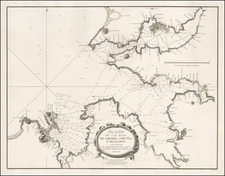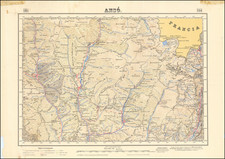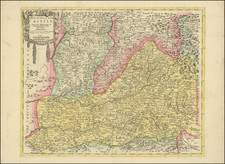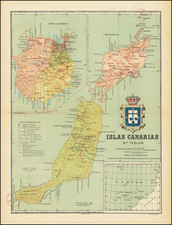Good example of Braun & Hogenberg's view of Alhama de Granada, from Braun & Hogenberg's Civitates Orbis Terrarum, the most important book of town plans and views published in the 16th Century.
The view shows a dramatic rocky landscape in front of the city, which is embedded in the Valley of the Marchan. In the foreground, the road to Granada can be seen. The Spanish city of Alhama de Granada is still known for its baths today. It was the Romans who discovered the hot springs and built the first thermal bath in the town, which was known then as Artigi. In the 8th century, the Moors conquered the Tolosan Kingdom of the Visigoths and gave Artigi the new name Alhama, derived from the Arabic word al-hamma meaning "hot water". After the end of the Reconquista in the 15th century, Alhama de Granada became a popular destination of the Spanish nobility. Alhama is in the southwest of the province of Granada and is enclosed by the Alhama River.
The text on the verso translates as follows:
Alhama is not the least of Spain's cities and is seven miles away from the splendid city of Granada. [...] The city and its surroundings have been richly endowed by nature: considering its fertile soil, high mountains, valleys and rivers, this place lacks nothing. And yet all these gifts are far surpassed by the warm baths that spring up there [...]. These baths are considered, not unjustly, one of the most amazing wonders in the whole of Spain.
Georg Braun (1541-1622) was born and died in Cologne. His primary vocation was as Catholic cleric; he spent thirty-seven years as canon and dean at the church St. Maria ad Gradus, in Cologne. Braun was the chief editor of the Civitates orbis terrarum, the greatest book of town views ever published. His job entailed hiring artists, acquiring source material for the maps and views, and writing the text. In this role, he was assisted by Abraham Ortelius. Braun lived into his 80s, and he was the only member of the original team to witness the publication of the sixth volume in 1617.
Frans Hogenberg (ca. 1540-ca. 1590) was a Flemish and German engraver and mapmaker who also painted. He was born in Mechelen, south of Antwerp, the son of wood engraver and etcher Nicolas Hogenberg. Together with his father, brother (Remigius), uncle, and cousins, Frans was one member of a prominent artistic family in the Netherlands.
During the 1550s, Frans worked in Antwerp with the famous mapmaker Abraham Ortelius. There, he engraved the maps for Ortelius’ groundbreaking first atlas, published in Antwerp in 1570, along with Johannes van Deotecum and Ambrosius and Ferdinand Arsenius. It is suspected he engraved the title page as well. Later, Ortelius supported Hogenberg with information for a different project, the Civitates orbis terrarium (edited by Georg Braun, engraved by Hogenberg, published in six volumes, Cologne, 1572-1617). Hogenberg engraved the majority of the work’s 546 prospects and views.
It is possible that Frans spent some time in England while fleeing from religious persecution, but he was living and working in Cologne by 1580. That is the city where he died around 1590. In addition to his maps, he is known for his historical allegories and portraits. His brother, Remigius, also went on to some fame as an engraver, and he died around the same time as his brother.









![Utriusque Castiliae nova descriptio [New Description of Both Castiles]](https://storage.googleapis.com/raremaps/img/small/79695.jpg)



![[Basque Coast] Die Zee Custen van Biscaijen tuschen Laredo en Sentillana soe hem dat Selue landt all daer vertthoornt enn opdoet . . . 1583](https://storage.googleapis.com/raremaps/img/small/61468.jpg)
